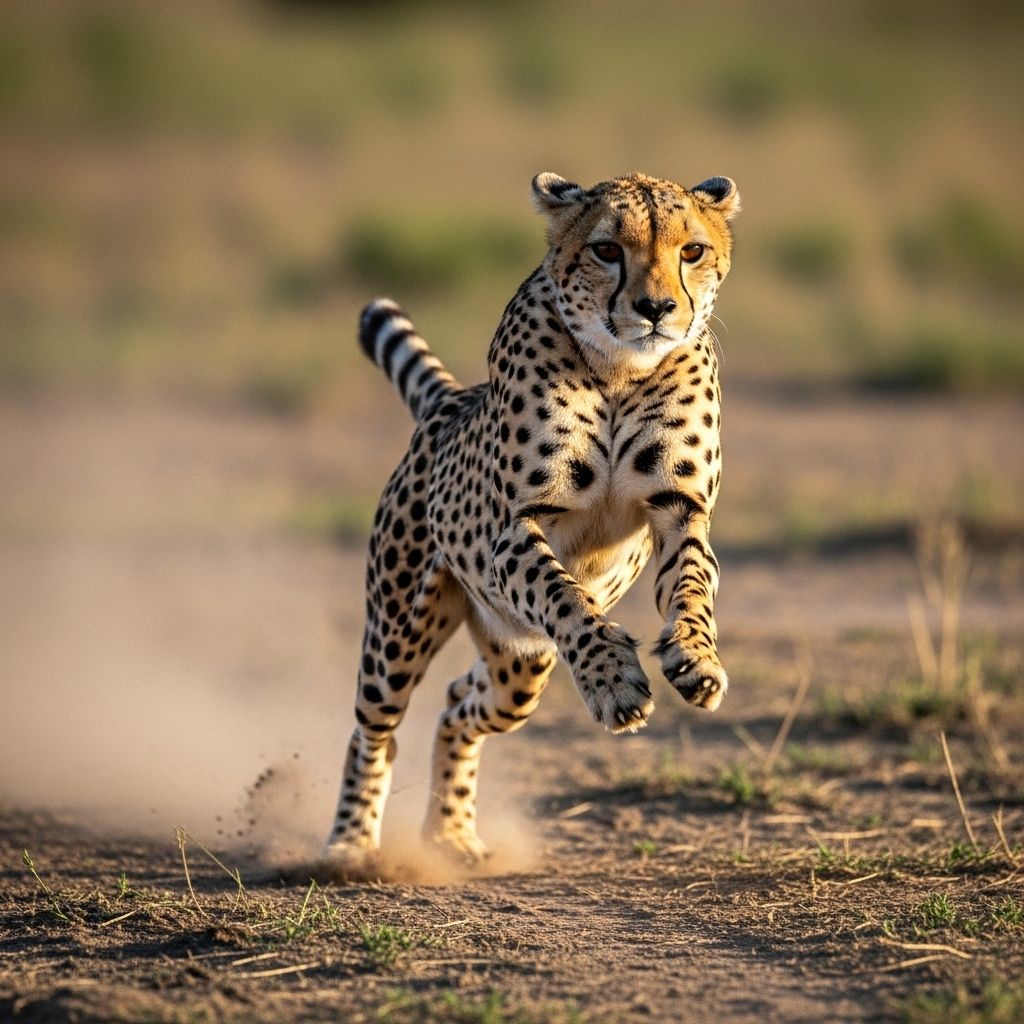How Fast Can A Cheetah Really Run: What You Need To Know
Explore nature’s speed champions achieving and sustaining jaw-dropping velocities.

How Fast Can a Cheetah Really Run?
Cheetahs are renowned across the globe as the fastest land animals, but exactly how fast can these spotted felines run? The answer is as astonishing as it is complex, involving a blend of cutting-edge research, anatomy, and evolution. While classic estimates credit cheetahs with a top speed of 68 to 74.5 mph (110 to 120 km/h), recent studies suggest slightly lower but still jaw-dropping figures for wild animals and those tested in controlled conditions. Whatever the maximum, the cheetah’s ability to accelerate faster than a sports car and change direction mid-sprint sets it apart in the animal kingdom.
The Anatomy of Speed: What Makes a Cheetah So Fast?
The cheetah’s speed is the result of a suite of anatomical adaptations that have evolved over millennia:
- Lightweight, slender body: Reduces air resistance and maximizes acceleration.
- Flexible spine: Acts like a spring; during running, the spine flexes and extends so extremely that the animal’s front and hind legs overlap, extending stride length to 21–25 feet (6–7 meters).
- Long legs and tail: Provide both powerful stride and remarkable stability—the tail acts as a rudder to balance the body during sharp turns.
- Semi-retractable claws: Function like cleats for maximum traction; these are more dog-like than feline, always ready for rapid acceleration.
- Unique muscle structure: Specialized muscles swing limbs at incredible speed, generating the force needed for their legendary acceleration.
- Hard, flat foot pads: Offer increased grip during high-speed, twisting runs.
How Fast Can a Cheetah Accelerate?
Lab and field studies have found that cheetahs can go from 0 to 60 mph (0–96 km/h) in less than three seconds—a feat on par with, or superior to, the fastest road cars. Acceleration is further aided by explosive bursts of speed, with researchers reporting that cheetahs can increase their speed by 10 km/h (6 mph) in a single stride.
Maximum Speed: Do Cheetahs Really Hit 75 mph?
Traditionally, cheetahs were believed to reach speeds between 68 and 74.5 mph (110–120 km/h). However, recent measurements using advanced tools like high-speed cameras and GPS collars have recorded lower but more consistent speeds:
- 61 mph (98 km/h): Cincinnati Zoo’s Sarah, one of the fastest measured cheetahs in controlled testing.
- 58–65 mph (93–104 km/h): Wild cheetahs in sprint, with bursts typically lasting 1–2 seconds.
- 63.7 mph (102.5 km/h): Long-standing record from a 1965 Kenyan sprint by a tame cheetah chasing a Land Rover.
For comparison, even elite human sprinters like Usain Bolt peak at just under 28 mph (45 km/h)—with cheetahs easily doubling or tripling that speed.
How Long Can a Cheetah Maintain Top Speed?
Cheetahs are sprinters, not marathoners. They can sustain top or near-top speeds for only 200–300 meters (about 20–30 seconds). Beyond this, the energy cost and heat generated become overwhelming—the animal must stop to rest and recover for up to 30 minutes to avoid overheating and exhaustion.
Comparing Cheetahs to Other Fast Animals and Cars
| Species/Vehicle | Top Speed (mph) | Top Speed (km/h) |
|---|---|---|
| Cheetah | 61–75 | 98–120 |
| Usain Bolt (Human) | ~28 | ~45 |
| Pronghorn Antelope | ~55 | ~88 |
| Lion | ~50 | ~80 |
| Ferrari LaFerrari (Car) | 217 | 350 |
The cheetah’s secret, however, isn’t just raw speed—it’s the lightning acceleration and agility that allow it to chase down nimble prey like gazelles, which themselves can reach speeds near 50 mph (80 km/h).
Why Do Cheetahs Run So Fast?
Cheetahs’ high speed is an evolutionary adaptation for catching prey in open habitats. Their main diet includes fleet-footed antelopes (like gazelles) and, sometimes, hares or young wildebeest. The savannah offers little cover; so, cheetahs rely on short, explosive sprints to surprise and outrun prey in brief chases over open ground.
- Hunting Strategy: Silent approach to within ~100 feet (30 meters), followed by high-speed chase.
- Agility: Exceptional balance and rapid directional changes with the help of their tail.
- Energy Management: Quickly exhaust themselves, must rest before eating—vulnerable to scavengers during recovery.
Speed vs. Stamina
Cheetahs trade stamina for speed. Unlike wolves or wild dogs, which can run long distances to wear down prey, cheetahs commit to an ‘all-or-nothing’ sprint. If they don’t catch their prey within a minute, they abandon the chase to avoid endangering themselves through overheating.
Unique Features Supporting Cheetah Speed
- Non-attached shoulder blade: Allows free movement and greater stride extension.
- Pivoting hips: Let rear legs stretch far apart, maximizing stride length.
- Large nasal passages and lungs: Support oxygen intake during sprints, vital for brief aerobic endurance.
- High concentration of fast-twitch muscle fibers: Supports explosive, short bursts of speed but not endurance running.
Frequently Asked Questions About Cheetah Speed
Q: What is the recorded fastest speed for a cheetah?
A: The highest measured speed is 63.7 mph (102.5 km/h) from a 1965 Kenyan sprint. In recent tests with advanced tech, the top reliably measured speed is around 61 mph (98 km/h), with most wild runs peaking between 58–65 mph.
Q: Can cheetahs maintain top speeds for long distances?
A: No. Cheetahs sustain their maximum speed for just 200–300 meters before they must stop to avoid overheating and fatigue.
Q: How does a cheetah’s acceleration compare to a car?
A: Cheetahs can accelerate from 0–60 mph in under 3 seconds, rivaling or beating many high-performance sports cars in terms of burst speed.
Q: What adaptations help cheetahs run so fast?
A: Special adaptations include a flexible spine, semi-retractable claws, lightweight body, long legs, hard footpads, and a muscular tail for balance.
Q: Why don’t other big cats run as fast?
A: Other big cats like lions and leopards are heavier and built for power rather than speed; their bodies prioritize strength for wrestling and climbing over sheer velocity and acceleration.
Current Threats to Cheetahs
While cheetahs dazzle with their incredible speed, they are among Africa’s most endangered big cats. Habitat loss, declining prey populations, and human conflict threaten their continued survival. Today, conservationists work to protect the sparse, open grasslands cheetahs rely on and ensure that their unique gifts as sprinters do not vanish into extinction.
- Habitat Fragmentation: Loss of suitable hunting grounds.
- Prey Reduction: Competition with humans and other predators for food.
- Poaching and Conflict: Persecution by farmers and poachers.
Cheetah Speed—Fascinating Facts in Brief
- Cheetah stride length can reach up to 25 feet (7 meters) at top speed.
- Each stride completed in as little as 0.25 seconds, with four strides per second.
- During some phases of running, all four feet are off the ground—twice per stride.
- Young cheetahs reach nearly half their adult running speed by age 2, with play and chasing honing their skills.
- Cheetahs use their tail like a boat’s rudder—counterbalancing body weight and steering rapid turns while pursuing prey.
Why Cheetah Speed Matters: Nature’s Racing Machine
The cheetah is a marvel—not only due to headline-grabbing sprinting records, but because of the evolutionary engineering that produces such raw, nimble speed. Every anatomical feature, from claw to lung, is honed for one singular mission: outrun everything else on land, if only for a few electrifying seconds. In a world where survival can depend on the outcome of a chase, cheetahs truly embody nature’s definition of speed.
Further Reading & Resources
- Cheetah Conservation Fund: Insights into cheetah biology and conservation.
- Thomson Safaris: Big cat facts and safari guides.
- BBC Wildlife: Mammal records and expert guides.
- Wildlife Conservation Society (WCS): Scientific perspectives on cheetah speed limits.
References
Read full bio of Shinta












